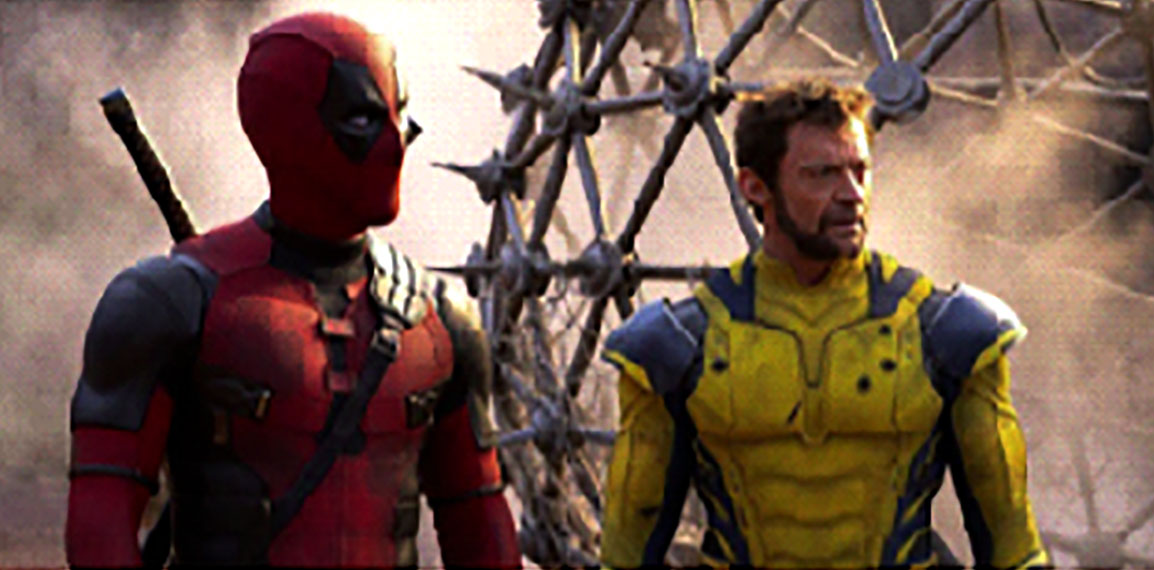The promised thrill of “Deadpool & Wolverine”, the third cinematic outing of Ryan Reynolds’ Deadpool, is found in its title. The aggressive ad campaign preceding its release stoked excitement by underlining the inevitable personality clash of the two foul-mouthed superheroes. We last saw Hugh Jackman’s Wolverine in 2017’s elegiac “Logan”, which culminated with the character’s death. Reynolds, who lobbied for Jackman’s return to the role, shares writing duties on the new film with its director Shawn Levy, and the additional trio of Rhett Reese, Paul Wernick and Zeb Wells.
You can tell from the opening scene, where Deadpool desecrates Wolverine’s grave, that those involved are aware, albeit self-consciously, of the dissonance in raising that particular superhero from the dead for a romp with this irreverent Deadpool. It’s a self-consciousness that will soon betray the filmmaking sensibilities in “Deadpool & Wolverine” where acknowledgement of a thing is treated as the height of engagement. In this film, portentous moments of drama or humour end at the set-up – follow through is not required. For all the excitement promised in the juxtaposition between Wolverine and Deadpool, the actual film is one where exigencies of plot, characterisation, meaning, or artistic acuity are rendered incidental.
Parallel universes have been a preoccupation of superhero films in recent years, and that complication presents a central plot-point for “Deadpool & Wolverine”. After the events of “Deadpool 2”, Wade Wilson (Deadpool’s alter-ego) is rejected from joining the Avengers. The rejection sends him into a tailspin that includes a break-up with his girlfriend Vanessa (Morena Baccarin) and him retiring from his vigilante days as Deadpool. This information is rendered in a series of sluggish flashbacks as the actual story finds Wade in the present day, where he faces a potentially life-changing predicament. Wolverine’s death has doomed Wade’s timeline, and although members of a formidable organisation called the Time Variance Authority are willing to save Wade, they will not save the group of friends he’s come to call family. This leaves him with no choice but to steal a device, returning to his Deadpool persona, to travel through the multiverse to find a variant of Wolverine in hopes of saving his timeline. This is the decision that finds us at the opening of “Deadpool & Wolverine”, with Deadpool performing some casual graverobbing amidst one of the more energetic fight sequences of the film.
The idea harbours enough dramatic potential to be potent but ends up more incidental than meaningful when “Deadpool & Wolverine” can only offer the most ambivalent lip service to what makes this group of people so meaningful to Wade. Although the in-universe plot of the film insists that Wade has spent six years without embodying the precocious persona of Deadpool, the film has little interest or ability to distinguish this third iteration of Wade or Deadpool as a figure who has been affected by anything in his past. His yearning to join the Avengers is pitched as something sincere, but the film cannot articulate how. The breakup with Vanessa is invoked throughout as an act of genuine pain for him, but the actual pain of the breakup is never truly realised in any scene that dares to approach any semblance of emotional honesty, or even cleverness. Deadpool has always used his humour to avoid his vulnerability, but the previous films have reckoned with this dichotomy in more ingenious ways. In “Deadpool & Wolverine”, each plot turn reveals a film unwilling to confront the dramatic potential for anything emotionally risky for more than a few beats. But, who has the time for emotional stakes when there are self-referential possibilities to offer the audience on a platter?
The run up to the global premiere of “Deadpool & Wolverine” has been rife with warnings for audiences to be mindful of revealing spoilers. It’s a familiar part of the comic-book movie cycle, and especially that of Marvel’s Cinematic Universe, to which “Deadpool & Wolverine” belongs. Films dependent on surprising plot points or unexpected character developments tend towards guarding their audience’s access to information that might spoil the surprise-dependent viewing experience. But in “Deadpool & Wolverine”, the threat of a spoiler is not bound to plot, or even characterisation. Instead, it is bound to a kind of corporate self-promotion that demonstrates an inherent shallowness of the film, and the current state of the machine that is the Marvel Cinematic Universe, now in its fifth phase. Fatigue has set in.
The tightly guarded spoilers hinge on the appearance of several “surprise” characters – rendered in extended cameos by a handful of familiar performers. With each cameo, the momentum of the film pauses. It is as if the appearances are modulated in anticipation of a requisite thrum of entrance applause. Look, it seems to say, see who we’ve got to appear? Any dramatic impulse ends at the moment of recognition of the reference. At best, their appearances shuffle us along to the next lethargic plot point, and at worse they function as brief attempts to satiate us with false levity, leaving the actual film as misshapen and incongruous as ever, when they vanish. That these recurring acts, and there are many, are the height of what might be spoiled for audiences reveals a gaping emptiness at the centre of “Deadpool & Wolverine”.
It is a tendency that exemplifies the stunning lassitude of the dramatic throughline at work in the film. The referential moments rain down on you in torrents. Deadpool’s fourth-wall breaks are as foul-mouthed as before, but feel knowingly conscious that they exist within a tightly limited product that lacks the specificity of something with its own personality. Jackman wearily stalks through the film trying to draw nuance from this version of Wolverine. The formlessness is evident in the hapless intentions of the primary villain Cassandra Nova (Emma Corrin) whose hazy desires shift whenever the film needs it to, despite her reported power. By the halfway point it begins to feel like an aggressive onslaught wearing you down to accept its vision of entertainment as the only way for a film like this to be – a hodgepodge of things thrust together because they can be. Deadpool tells us how we should feel, and the film expects us to fall in line.
Every successive quip in “Deadpool & Wolverine” is keenly aware of the oversize power and influence the MCU has. The extensive soundtrack is excellent, spanning decades of pop music that likely cost much to licence. But all the money in the world cannot help the filmmakers use music to eloquently augment what happens on screen. The thrill is the recognition of a popular song, no further thought is put into how it functions. If we are meant to be tickled by the absurdity of how little the songs offer anything meaningful to the tension (or lack thereof) onscreen, that would only be the nail in the coffin in how much “Deadpool & Wolverine” emerges as a kind of anti-cinema. Meaning is scant in the actual diegesis of the film and all that we see and hear exist as merely a referent thrill to provide audiences with a spark of recognising a thing that lets us feel good about being in the know. It doesn’t have to be this way. Consider the clever blend of humour and pathos in “Deadpool 2” which features Celine Dion’s earnest mournfully singing of the original song “Ashes” over the irreverent credits of the film, after Deadpool suffers an emotional loss. That kind of inventive specificity is all but absent in “Deadpool & Wolverine”.
Worse yet, all the money in the world cannot help “Deadpool & Wolverine” to repair its stunningly flat-footed imagery. The titular duo spend much of their time in a place called the Void, a kind of purgatory where those the universe rejects are sent to waste away. In one of the infinite fourth-wall breaks, Deadpool muses about the Void’s similarity to the dystopian wasteland of the Mad Max World. That “Deadpool & Wolverine” arrives in cinemas mere weeks after the imagistic thrills of George Miller’s “Furiosa ” only emphasises the lack of emotional identity in the onscreen images. So much of what develops feels like a startling disavowal of the visual powers of cinema and a frustrating disengagement with the visual appeal of the possibility of comic-book films. The colours on display might suggest an affinity to the energetic verve of a comic-book frame, but “Deadpool & Wolverine” lacks any of the visual depth that you find within a panel. This is the work of a filmmaking team that is unable or unwilling to communicate its humour through the visual potential of the cinematic form. Instead, it can only reach for the low-hanging fruit of relentless and hollow jesting.
The dramatic effect of “Deadpool & Wolverine” feels tantamount to filmmaking as an exercise in signifiers in place of actual substance. Each moment offers a reference, or a cameo, or a nod to something. It is movie making by way of ephemeral needling. When the emptiness of the needling is revealed, we are thrust into another sequence of listless referencing to satiate us. This is not a film that revels in the power of storytelling but is instead a formless piece of content that is happy to move from moment to moment of reference to satiate with the thrill of identifying the mere shape of a joke as its apex. It wants to wear us down – bludgeoning us with its rat-a-tat assault of trenchant quips. At every turn, this is a film that gleefully announces that every moment, every sequence, does not develop from a natural interest in building its story. Instead, it wallows in its outsize state of infallibility. It does what it wants, merely because it can. These characters deserve better. So do we.
Deadpool & Wolverine is playing in cinemas






